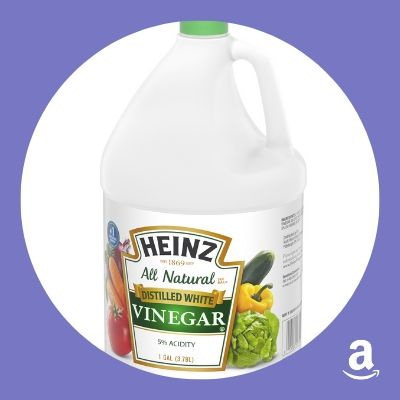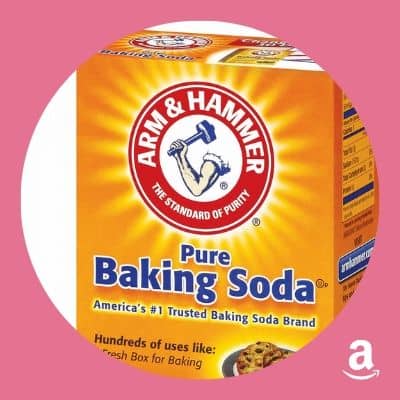Recently, I’ve been on a mission to find and use more natural products in my home. My hope is to decrease our use of chemicals over time and find products that are safe for our family. We have members with very sensitive skin, severe allergies, and chronic health conditions. We don’t need to add to our health problems by using chemicals that are known to irritate or make some conditions worse. I figured the laundry room was an excellent place to start.

We were using a laundry detergent that has some ingredients that are known for being skin and allergy irritants and possible carcinogens. No, thank you. We’ve also had problems with smelly laundry because of fabric softener, so I’ve had to find other alternatives to using liquid fabric softener.
So as I do, I searched far and wide for safe and natural products to start using in place of my toxic ones. I found so many amazingly helpful people out there sharing their homemade recipes for natural fabric softeners, natural deodorizers, and DIY dryer sheets. Making my laundry smell good while actually being clean, and now safe, is really important to me.
So let’s get into it.
Natural Laundry Deodorizers
Keeping our clothes and towels smelling fresh and free of stale and musty odors is crucial. Well, at least is it to me. I can’t stand when my clothes don’t smell clean or when I bring a towel to my face after a shower and it smells of mildew. I just recently took on getting rid of the mildew smell in my towels using 5 easy methods, including the three natural ones below.
Vinegar – Using vinegar in your laundry can neutralize odors, and it is antibacterial as well. Add ½ – 1 cup of vinegar in the place of your detergent or do a vinegar pre-soak by adding some water and vinegar to a washtub and letting the laundry soak for 30 minutes to one hour.
Baking soda – Add ½ cup of baking soda to your next load of laundry to make your detergent even more effective at removing odor-causing bacteria. Do an overnight soak in water and baking soda for the best results.
Borax – The alkaline nature of borax kills odor-causing mold, mildew, and bacteria. Add a ½ cup of borax to the washing machine drum and wash as usual.
Natural Fabric Softeners
What does a fabric softener do?
Before we get into the natural fabric softeners, we should talk about what a fabric softener does in the first place. Many commercial fabric softeners contain a silicone-based liquid and/or a class of chemicals called quaternary ammonium compounds or “quats” that are commonly used in cleaning products for their antimicrobial properties. Quats in fabric softener help with static cling and “softness” by coating the fibers with a waxy layer.
The issue is that these ingredients are harmful to your health as well as your clothing. I learned this when I noticed that my towels weren’t smelling good, and they weren’t absorbent any longer. I found out that the build-up of the waxy compounds in my fabric softener was one of the culprits. I strip washed all of my clothes, towels, and bedding to remove the fabric softener residue and have vowed never to use the stuff again.
As for health problems, what I found was definitely concerning, especially because of my family’s specific health conditions. While I love the fragrance that fabric softener gives my clothes and it helps with static cling, it just isn’t worth the risk.
Homemade Fabric Softener
You may begin to notice a trend while reading through this article when it comes to products. The same tried and true inexpensive household products make a repeat appearance as we talk about more natural and chemical-free alternatives to commercial laundry products. The products below have multiple purposes when used in your laundry routine, and they are great non-toxic natural fabric softeners as well.
Vinegar – It couldn’t be easier to use vinegar as a fabric softener. Add a ½ cup into the fabric softener dispenser on your washing machine or during the rinse cycle.

Vinegar and essential oils – Your favorite essential oils could be added to the vinegar to give your laundry a light scent. Note: there is a risk of essential oils igniting while being heated in the clothes dryer. Use it at your own discretion.
Baking soda – During the wash cycle, baking soda acts as a water softener and neutralizes the pH, thus preventing mineral build-up in your laundry. Baking soda is gentle and a great choice for those looking for a fabric softener for sensitive skin.
Borax – If you have hard water as we do, then adding a bit of borax to your wash will help with keeping the mineral deposits at bay, and by doing so, leaving your fabric softer.
DIY Fabric Softener Recipes
In this section, I will list all the natural fabric softener recipes I have come across so you can check them out and see what might work best for you. If there are any modifications that I would personally make, then I will note that as well.
Whole Lifestyle Nutrition’s Natural Scented Fabric Softener
You’ll need:
Note: the author uses the quart vinegar container and adds the essential oils directly to it. Make sure the bottle is glass if it is going to be used to store the solution as essential oils and plastic don’t play well together.
Add essential oils of your choice to a quart of white vinegar. Add ¼ – ½ cup to the fabric softener dispenser of the washing machine.
In Jennie’s Kitchen Natural Fabric Softener
This fabric softener recipe calls for the optional addition of fresh herbs such as mint or thyme.
You’ll need:
Put 2 cups of white vinegar and 10 drops of essential oil into the container and shake to mix. Add in ¼ cup to the fabric dispenser of your washing machine.
Overthrow Martha’s Natural Fabric Softener
This fabric softener recipe was unique in that it has the addition of rubbing alcohol or vodka to the mix. Alcohol is a great stain fighter and disinfectant.
You’ll need:
Combine 3 cups of white vinegar, ¼ cup alcohol, and about 20 drops of essential oil into the jar. Shake the jar well to mix. To your fabric softener dispenser on your washer, add in ½ – ¾ cup of the natural fabric softener.
The Things We’ll Make DIY Natural Fabric Softeners
You will find multiple recipes on this page for homemade fabric softeners. This recipe focuses on the baking soda and essential oil recipe, but go ahead and try the others too!
You’ll need:
Add 2 cups of baking soda to your jar. Then add 15 drops of essential oil and stir well. During the rinse cycle, add in ½ cup of the mixture into the drum with your laundry. Note: this may be difficult for those who have front-loading machines. In this case, add the mixture to the start of the load.
Everyday Roots Homemade Fabric Softener
This recipe uses Epsom salt, or any salt for that matter, which has a bit of controversy around using it in the wash. However, there are many success stories out there for using it as a part of a natural fabric softener recipe. My recommendation is to do your own research and determine if it is right for you to use in your machine.
You’ll need:
Combine 2 cups of Epsom salt or sea salt along with 20-30 drops of essential oils in your jar and mix well. Add in ½ cup of baking soda and mix well again. Add 2-3 tablespoons into the load right at the start of the wash. Note: the directions say to add “before rinsing,” but the author clarifies in the post comments that she meant before the wash and not the rinse.
Hello Glow’s DIY Fabric Softener Crystals
This recipe uses salt, which some argue that it is corrosive to the washing machine and should not be used. Again, I recommend doing your research or talking to your appliance manufacturer.
You’ll need:
Thoroughly mix 4 cups of salt and 20 drops of essential oil together in the jar. Add a few tablespoons of the mix to small loads, and for larger loads, add 4-8 tablespoons.
Homemade Dryer Sheets
DIY Dryer Sheet Recipes
Nature’s Nurture’s Essential Oil Dryer Sheets
This recipe is super easy and can be done on the fly.
You’ll need:
Wet the cloth with water and wring the excess water out. Then add 5 drops of essential oil to the damp cloth and add to the dryer with the clothes about 10 minutes before the end of the dry cycle.
Full Green Life’s Fabric Softener Sheets
These homemade dryer sheets are made ahead of time and stored in a tight-sealing container until they are needed.
You’ll need:
Load your cloths into the container. Add ½ cup water, 1 ½ cups white vinegar, and around 20 drops of essential oils to a bowl. Pour the solution from the bowl into the container over the cloths. Add one sheet to each dryer load at the start.
Bren Did’s Natural Homemade Dryer Sheets
This dryer sheet recipe is a little different as it has the added ingredient of vegetable glycerin.
You’ll need:
Combine 2 cups vinegar, 2 cups water, ⅛ cup vegetable glycerin, and 10-20 drops of essential oil inside the mason jar. Add your cloths to the solution. When ready to use, wring out the excess solution from the dryer sheet into the jar. Add the sheet to your clothes in the dryer at the start of the drying cycle. Note: this solution can also be used on its own as a liquid fabric softener.
Home Remedies for Static Cling
Homemade Anti-Static Cling Spray
This recipe is so simple yet effective. All you need is Witch Hazel and essential oils. You can put it in a small glass spray bottle for on the go.
You’ll need:
Add 1 cup of Witch Hazel and 5 drops of essential oil into the spray bottle and shake to mix. Spray onto clothes to get rid of static cling. You could probably add this spray to wool dryer balls as well.
Wool Dryer Balls
If you’ve been looking into natural laundry for any length of time, you have likely come across wool dryer balls. You can buy them pre-made, or you can DIY your own wool dryer balls. The only concern is making sure you don’t have any family members with wool allergies.
Hang Dry
If you have a clothesline to hang dry your laundry, it is the best method to get rid of static cling.
Humidifiers
Dry winters or environments cause more static. Putting humidifiers around your home will help with static cling in your laundry as well as those unpleasant shocks shared between people and objects.
Safety Pins and Aluminum Foil Ball
You can attach safety pins to a cotton cloth or dryer balls OR wad up a ball of heavy aluminum foil and add it to your load of clothes in the dryer. There is a lot of anecdotal evidence that these two methods work well to reduce static cling.

Natural Laundry is the Way to Go!
I don’t know about you, but I am really excited to try these ideas and recipes out in my laundry room. Not only are they safe and natural alternatives, but they are also a lot less expensive and easy to access. Many of these recipes have essential oils as an ingredient, but you don’t have to add them in unless you want scent. The real magic is in the other ingredients, so give them a shot!
What natural laundry alternatives do you love? Comment with your suggestions! We’d love to hear from you!















Leave a Reply